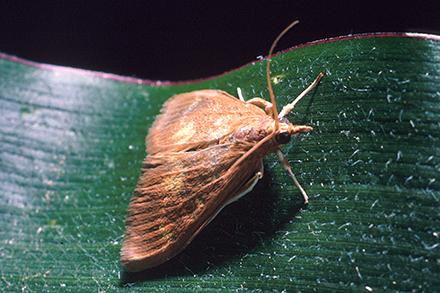What Can a Moth Teach Us About Adapting to Climate Change?
ARS scientists and collaborators are studying how genes in the European corn borer moth can help them survive variable climate conditions.
According to recent findings, the duration of cold temperature during winter is likely to shorten over the next century due to climate change. However, the impacts of climate change on some ecosystems are already very visible today.
While a number of insect species have declined in recent years, some species, such as Ostrinia moths and lanternflies, have instead expanded their presence well beyond their original geographic ranges. Other pest insects might have similar range expansions, but why certain species appear to be better at adapting to climate change is still a mystery, according to Brad Coates, a research geneticist at the ARS Corn Insects & Crop Genetics Research Unit in Ames, IA.
Together with collaborators from Tufts University, Coates is trying to solve that mystery. To do so, the group is studying the genes responsible for delayed development in two types of European corn borer moth, a species that causes damage to corn and other crops. Their research has led them to two genes, known as period (per) and pigment dispersing factor receptor (pdfr), as possible keys to adjusting to and surviving climate change.
All animals, including insects, have internal biological clocks controlled by unique regions of their brains. These “clocks” dictate an individual’s circadian rhythm, a repeating, 24-hour internal process that regulates the sleep–wake cycle. For insects, Coates found that the per and pdfr genes help regulate the timing of major circannual events, rhythmic annual biological processes – like reproduction and the entering of or exit from diapause (a dormant winter state) – that occur across the insect life cycle.
Since an insect’s survival depends on reaching diapause before winter, the ability to adjust to seasonal changes in temperature and day length are critical. Coates and his colleagues found that variations in the two genes allow the European corn borer additional flexibility in its circannual cycle, such as adjusting to environmental shifts like shorter or longer winters.
“By emerging from diapause at an appropriate time and adjusting the number of times they reproduce in response to the environment, insects like the European corn borer moth have an edge when it comes to using local food resources and maximizing opportunities to survive. In this case, longer summers and additional warm days lead these insects to reproduce more often,” explained Coates. “Being able to synchronize their biological activities to rapidly changing environments is a matter of life and death for all insects.”
Coates and his colleagues expect that variant forms of per and pdfr in the European corn borer will help scientists better understand the role that biological clocks play in an insect’s capacity to adapt to climate change. For example, variations of per and pdfr may affect the insects’ movement into regions that were previously uninhabitable due to incompatibilities with the timing of circannual cycles. As a result, researchers are now looking into how these genes may affect timing changes in hibernation, migration, and reproduction in other insects.
Their findings reemphasize the links between underlying molecular genetic mechanisms and responses to climate. Further research into these connections may help predict the effect of climate change on many insect species. With such information, Coates hopes that scientists and other stakeholders, including farmers and growers, can improve their efforts to conserve ecologically important species that are in decline while reducing damage caused by crop pests. – by Georgia Jiang, ARS Office of Communications.
You May Also Like


